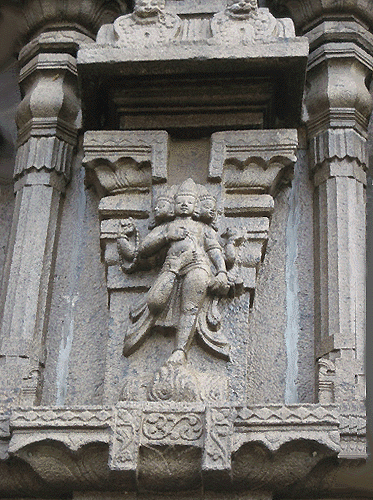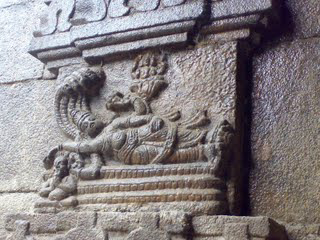
|
|
|
|
The name 'Pancheshti' refers to five yagnas performed by the sage Agasthiar: 'pancha' means five and 'ishti' means yagna. Because the place is blessed by Agasthiar, the temple grounds provide copious water, which are sometimes diverted to the City of Chennai during droughts. Referring to this, the sthalam is also called Pancham Theerkum Pancheti, meaning 'starvation solving Pancheshti'.
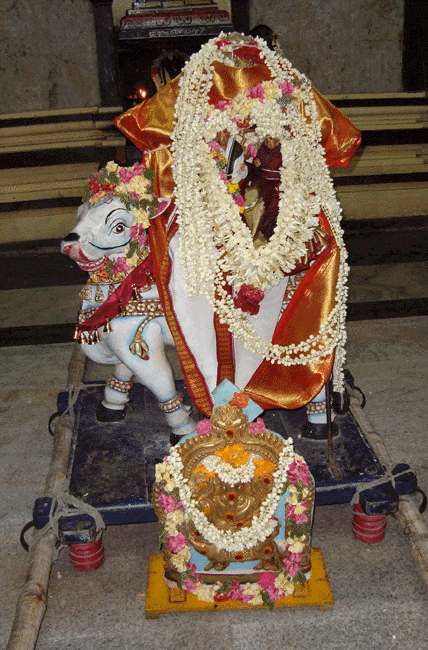
Sri Agastheeswarar The presiding deities in the temple are Sri Agastheeswarar and his consort Anandhavalli. While the two are in separate shrines in the sanctum sanctorum, devotees can get darshan of both from a single viewpoint. Agastheeswarar is facing east, while Anandhavalli faces south.
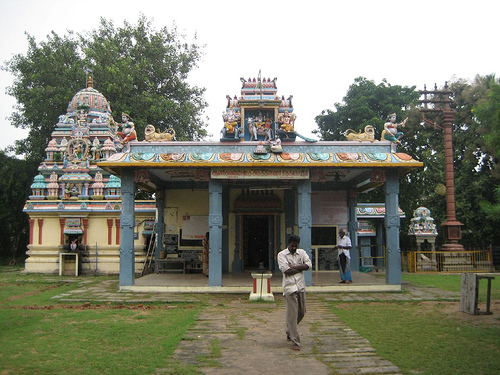
Entrance, Agastheeswarar shrine, Dwajastambha Sri Agastheeswarar is a swayambhu (self-manifesting) lingam, who sits under the canopy of a five-headed Nagarajan. The lingam is believed to have been here before the arrival of Agasthiar, but was apparently given the name Agastheeswarar due to the sage's worship. Agastheeswarar is considered to be Shivasakthi due to Ambal manonmani being on his left side.
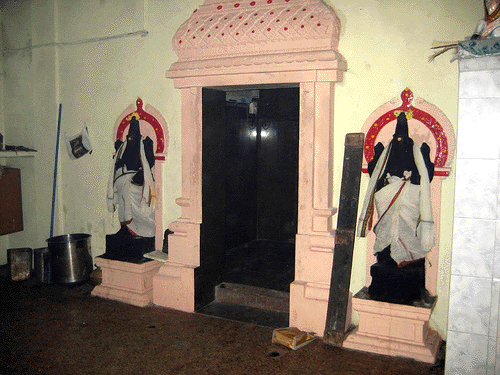
Entrance to Sanctum The deity of Anandhavalli Devi is exquisite, being made of Maragatha stone (emerald). She has three eyes, the right eye being the sun, and the left eye, the moon. Agasthiar installed a Durga Yanthram on a platform in front of Devi, which contains 700 mantras from the Sapthasee manthram of Devi Mahathmeeyam. These mantram glorify the forms of Laksmi Devi, Saraswati Devi, Durga Ma, and Kali. In separate shrines are deities of Lord Brahma, Mahavisnu, Dakshinamoorthy, Vinayakar, and Durga. Three additional images of Brahmadeva are found in the panel sculptures of the Rajagopuram.
Among the numerous koshtams (shrines) in the temple compound, in the outer praharam there is an interesting shrine for Balasubramaniar, whose deity is in Shrushti kolam, depicting Balasubramaniar performing the work of creation -- Lord Brahma's job. This serves as another indication of the transformation in temple cultures away from Brahma worship, segueing to personalities like Subramanya and Surya, before eventually going over to Shiva. In the outer praharam there are also shrines for Sidhi Vinayahar and Chandikeswarar. In the sanctum hall there are murtis of Sage Agasthiar and the ‘Naalvars’.
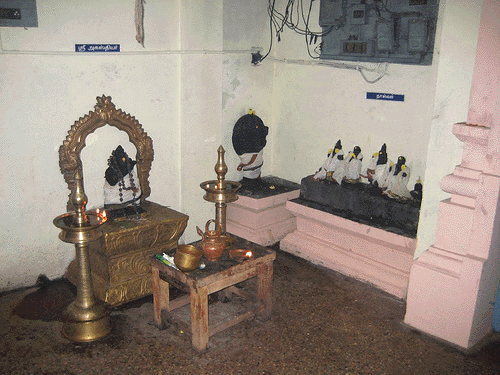
Agasthiar and Naalvar in sanctum Upon entering the Rajagopuram of this south-facing temple, one is greeted by the Navagrahas, who are directly facing Devi Anandhavalli, as she sits facing the entrance. While the different Navagraha typically face different directions, here they are all facing Ambal.
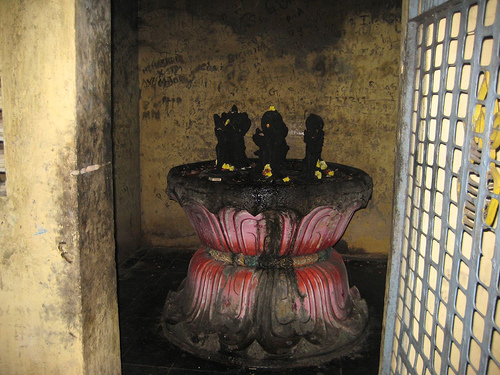
Navagraha Shrine Another main shrine, the Ishti lingam, is placed in the northern corner of the temple. This Shivalingam was worshipped by Agasthiar’s sishyar, the sage Pulathiar. A tree stands beside the shrine, serving as a canopy for the lingam.
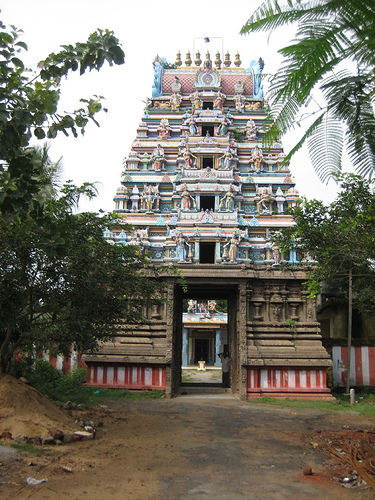
Main entrance The Rajagopuram, an imposing and beautifully ornamented structure, has intricate panels sculptured both inside and out. Although this is considered a Shiva temple, the panels depict many Vaisnava images, covering the different ages and incarnations, including Dasavatar.
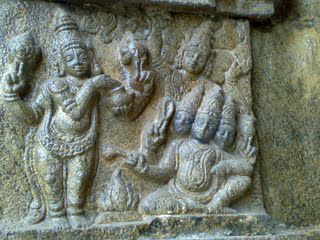
Lord Brahma performing Yagna with Mahavisnu Depictions of Lord Brahma are found on three of the numerous long panels in the temple compound. In one, we see Brahamadeva and Mahavisnu performing yagna together. In another is Brahma Thalam, and in a third is Brahma Sarathi. Elsewhere there are beautiful carvings of Lord Brahma performing penance on Agni, and the birth of Lord Brahma, with Garbhodakasayi Visnu.
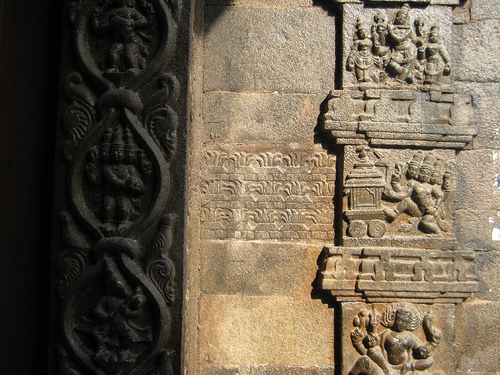
Brahma Sarathi (center image) Outside the eastern praharam is the temple tank, Agasthia Theertham, said to have been created when the Agasthiar drank the sea, spitting a little of it out in this place. The great sage later returned to Kailasam, at Shiva's urging, but he is said to visit here every Vaikasi full moon. Many devotees come to take bath on that day.
The temple's Sthala Vriksham is a vilvam tree. Outside, north of the praharam, is an ancient snake pit, still be inhabited. The naga is believed to be guarding hidden treasures beneath the temple.
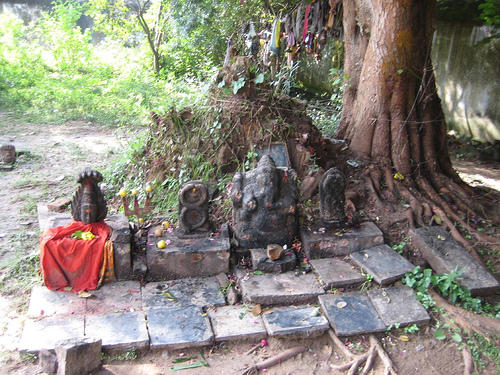
Naga pit with Naga and Ganapathi murtis Some photos courtesty of RajusTempleVisits@Flikr
| |
